stop start MAZDA MODEL CX-9 2018 Owners Manual (in English)
[x] Cancel search | Manufacturer: MAZDA, Model Year: 2018, Model line: MODEL CX-9, Model: MAZDA MODEL CX-9 2018Pages: 640
Page 93 of 640
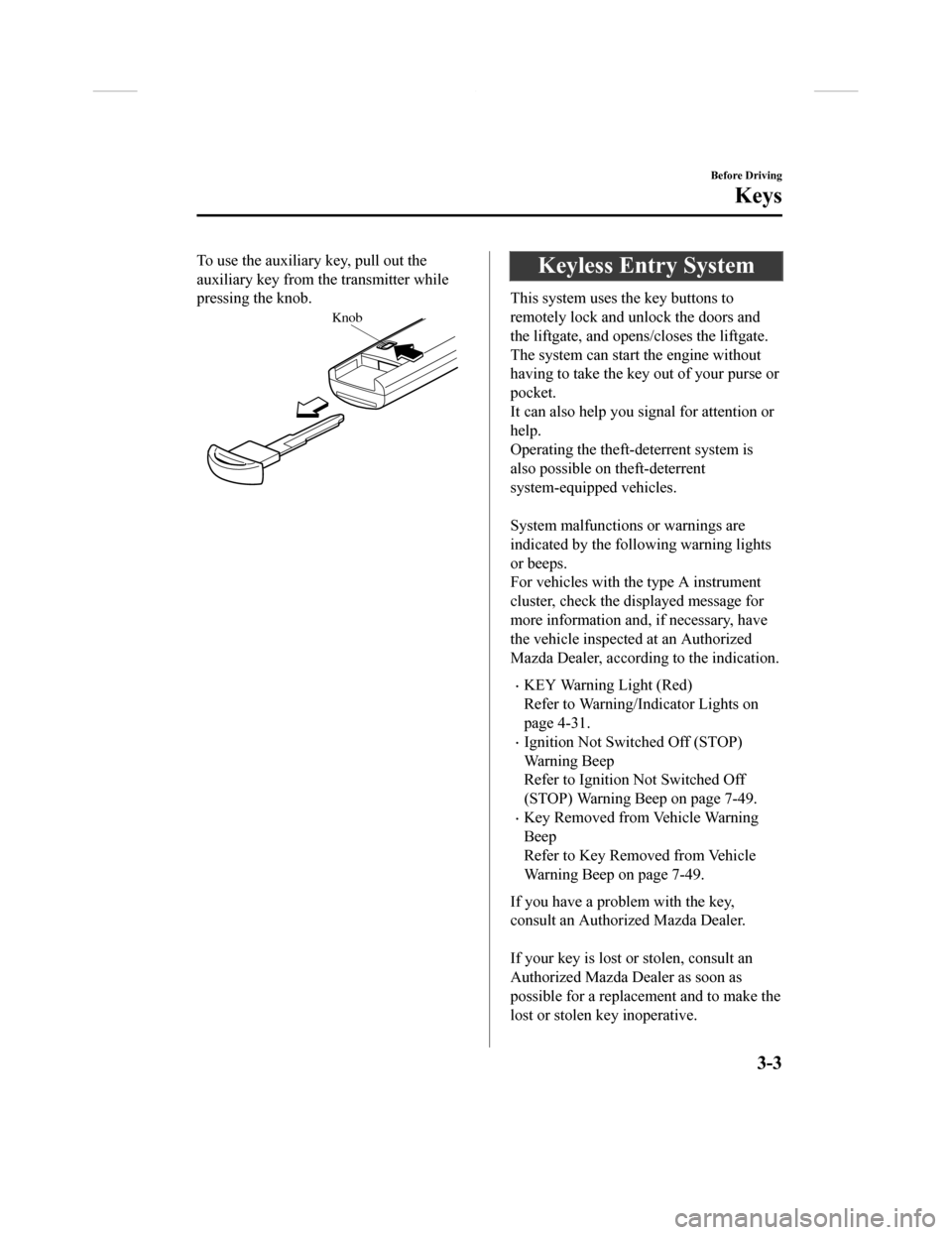
To use the auxiliary key, pull out the
auxiliary key from th e transmitter while
pressing the knob.
Knob
Keyless Entry System
This system uses the key buttons to
remotely lock and unlock the doors and
the liftgate, and opens/closes the liftgate.
The system can start the engine without
having to take the key out of your purse or
pocket.
It can also help you signal for attention or
help.
Operating the theft-deterrent system is
also possible on theft-deterrent
system-equipped vehicles.
System malfunctions or warnings are
indicated by the following warning lights
or beeps.
For vehicles with the type A instrument
cluster, check the displayed message for
more information and, if necessary, have
the vehicle inspected at an Authorized
Mazda Dealer, according to the indication.
•KEY Warning Light (Red)
Refer to Warning/Indicator Lights on
page 4-31.
•Ignition Not Switched Off (STOP)
Warning Beep
Refer to Ignition Not Switched Off
(STOP) Warning Beep on page 7-49.
•Key Removed from Vehicle Warning
Beep
Refer to Key Removed from Vehicle
Warning Beep on page 7-49.
If you have a problem with the key,
consult an Authorized Mazda Dealer.
If your key is lost or stolen, consult an
Authorized Mazda Dealer as soon as
possible for a replacement and to make the
lost or stolen k ey inoperative.
Before Driving
Keys
3-3
CX-9_8GC3-EA-17G_Edition1 2017-5-29 10:13:38
Page 98 of 640
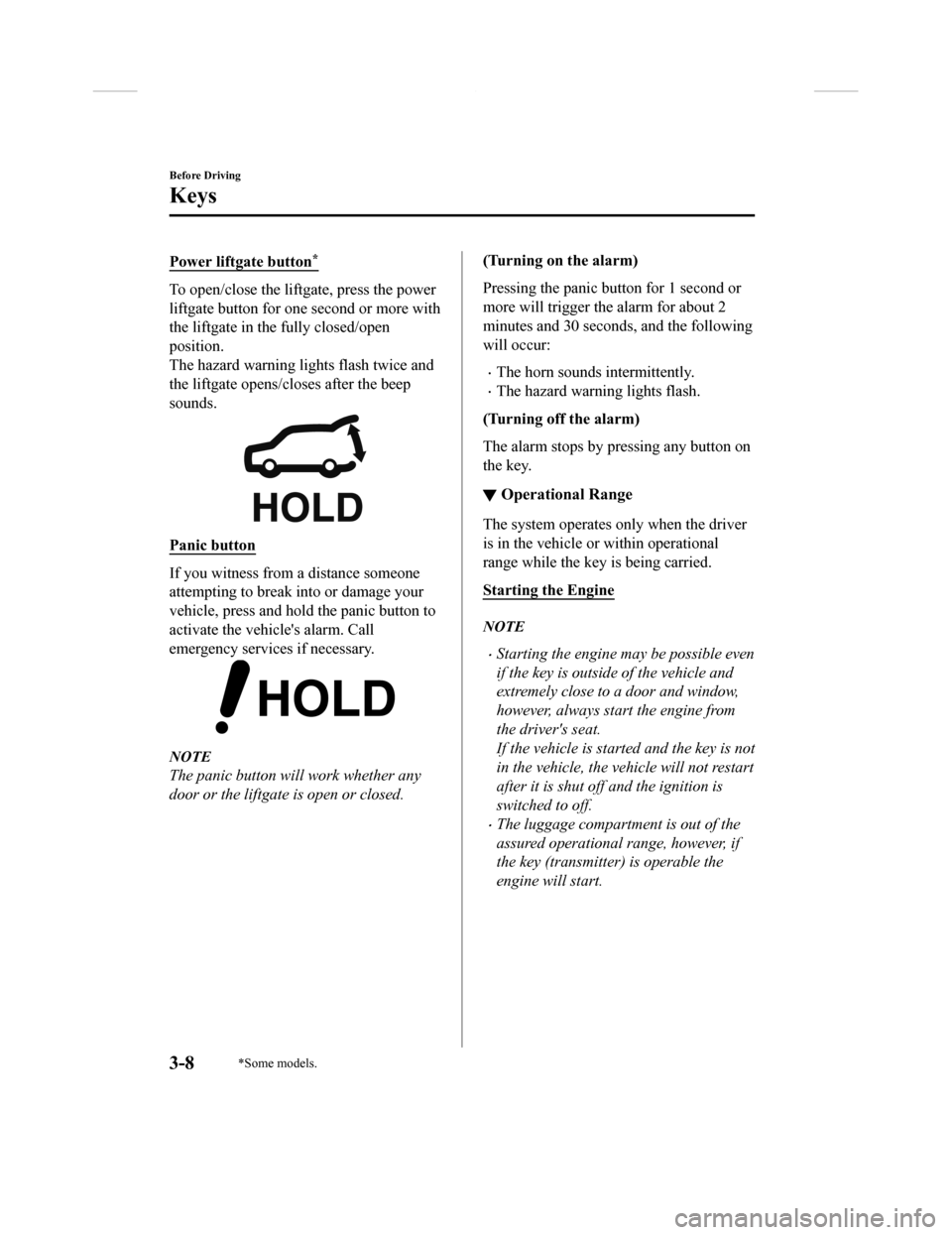
Power liftgate button*
To open/close the liftgate, press the power
liftgate button for one second or more with
the liftgate in the fully closed/open
position.
The hazard warning lights flash twice and
the liftgate opens/closes after the beep
sounds.
Panic button
If you witness from a distance someone
attempting to break into or damage your
vehicle, press and hold the panic button to
activate the vehicle's alarm. Call
emergency services if necessary.
NOTE
The panic button will work whether any
door or the liftgate is open or closed.
(Turning on the alarm)
Pressing the panic button for 1 second or
more will trigger the alarm for about 2
minutes and 30 seconds, and the following
will occur:
•The horn sounds intermittently.
•The hazard warning lights flash.
(Turning off the alarm)
The alarm stops by pressing any button on
the key.
▼ Operational Range
The system operates only when the driver
is in the vehicle or within operational
range while the key is being carried.
Starting the Engine
NOTE
•Starting the engine may be possible even
if the key is outside of the vehicle and
extremely close to a door and window,
however, always start the engine from
the driver's seat.
If the vehicle is started and the key is not
in the vehicle, the vehic
le will not restart
after it is shut off and the ignition is
switched to off.
•The luggage compartment is out of the
assured operational range, however, if
the key (transmitter) is operable the
engine will start.
Before Driving
Keys
3-8*Some models.
CX-9_8GC3-EA-17G_Edition1 2017-5-29 10:13:38
Page 121 of 640
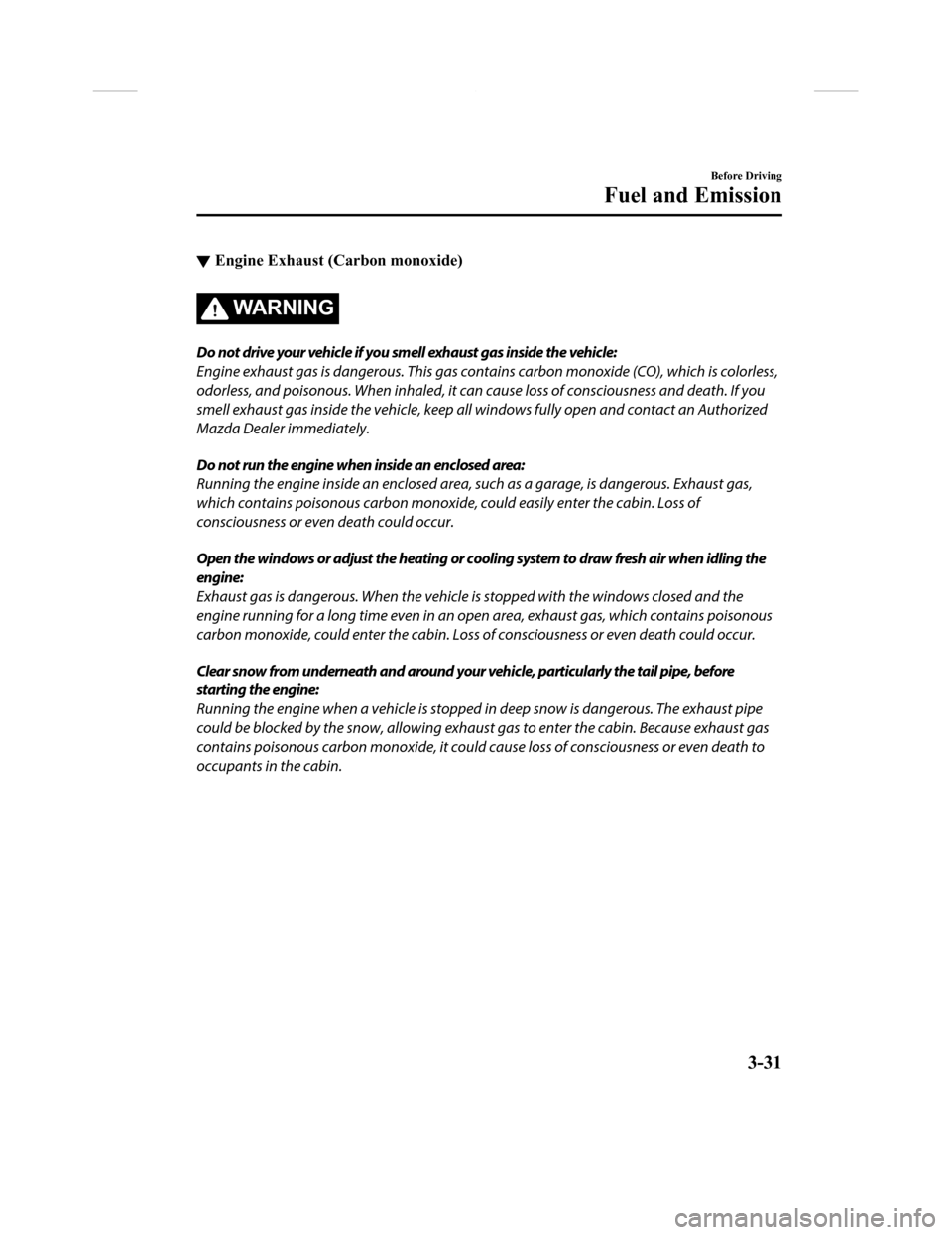
▼Engine Exhaust (Carbon monoxide)
WA R N I N G
Do not drive your vehicle if you smell exhaust gas inside the vehicle:
Engine exhaust gas is dangerous. This gas contai
ns carbon monoxide (CO), which is colorless,
odorless, and poisonous. When inhaled, it can cause loss of consciousness and death. If you
smell exhaust gas inside the vehicle, keep al l windows fully open and contact an Authorized
Mazda Dealer immediately.
Do not run the engine when inside an enclosed area:
Running the engine inside an enclosed area, such as a garage, is dangerous. Exhaust gas,
which contains poisonous carbon monoxide , could easily enter the cabin. Loss of
consciousness or even death could occur.
Open the windows or adjust the heating or cooling system to draw fresh air when idling the
engine:
Exhaust gas is dangerous. When the vehicle is stopped with the windows closed and the
engine running for a long time even in an open area, exhaust gas, which contains poisonous
carbon monoxide, could enter the cabin. Loss of consciousness or even death could occur.
Clear snow from underneath and around your vehicle, particularly the tail pipe, before
starting the engine:
Running the engine when a vehicle is stopped in deep snow is dangerous. The exhaust pipe
could be blocked by the snow, allowing exhaus t gas to enter the cabin. Because exhaust gas
contains poisonous carbon monoxide, it could cause loss of consciousness or even death to
occupants in the cabin.
Before Driving
Fuel and Emission
3-31
CX-9_8GC3-EA-17G_Edition1 2017-5-29 10:13:38
Page 138 of 640
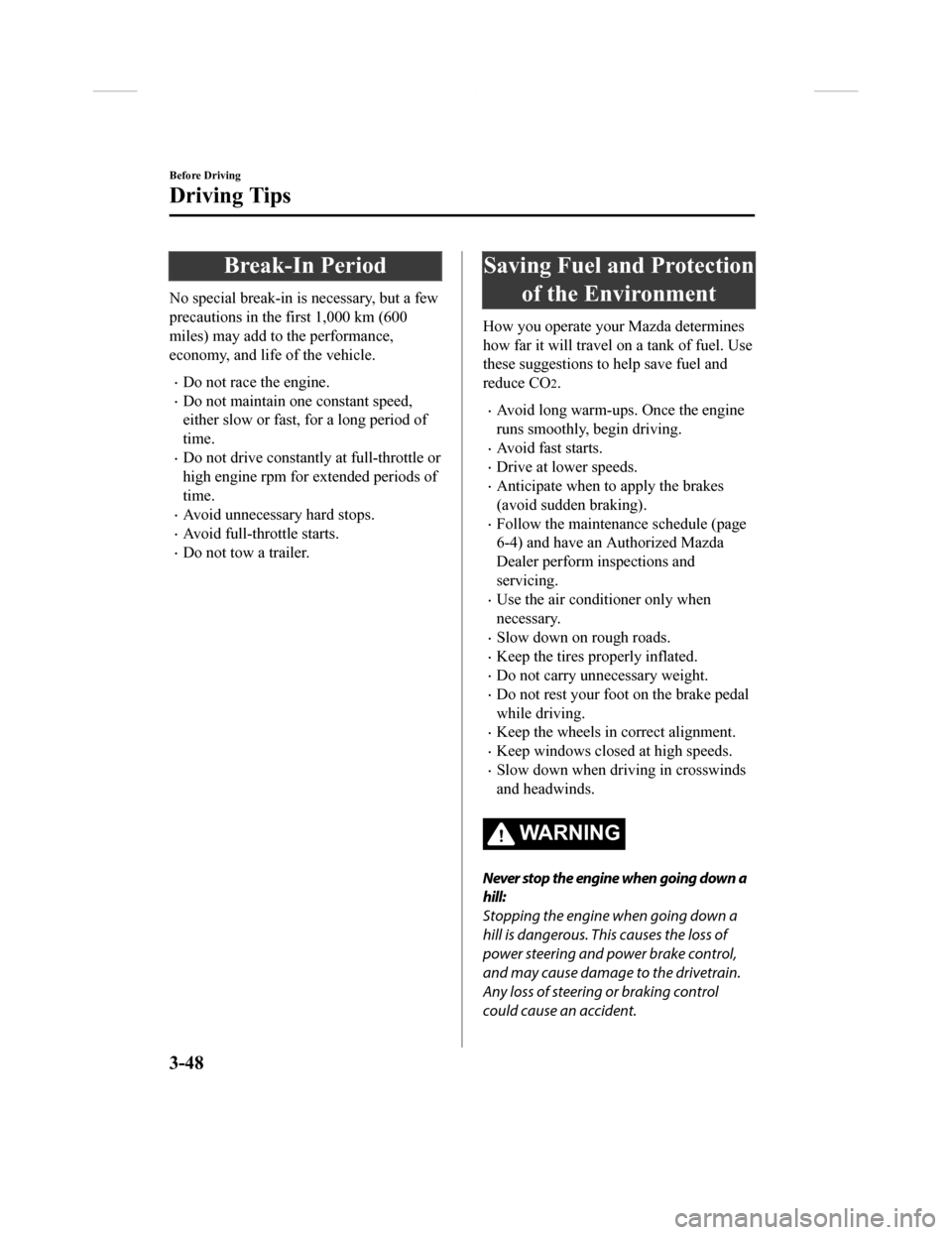
Break-In Period
No special break-in is necessary, but a few
precautions in the first 1,000 km (600
miles) may add to the performance,
economy, and life of the vehicle.
•Do not race the engine.
•Do not maintain one constant speed,
either slow or fast, for a long period of
time.
•Do not drive constantly at full-throttle or
high engine rpm for e xtended periods of
time.
•Avoid unnecessary hard stops.
•Avoid full-throttle starts.
•Do not tow a trailer.
Saving Fuel and Protection of the Environment
How you operate your Mazda determines
how far it will travel on a tank of fuel. Use
these suggestions to help save fuel and
reduce CO
2.
•Avoid long warm-ups. Once the engine
runs smoothly, begin driving.
•Avoid fast starts.
•Drive at lower speeds.
•Anticipate when to apply the brakes
(avoid sudden braking).
•Follow the maintenance schedule (page
6-4) and have an Authorized Mazda
Dealer perform inspections and
servicing.
•Use the air conditioner only when
necessary.
•Slow down on rough roads.
•Keep the tires properly inflated.
•Do not carry unnecessary weight.
•Do not rest your foot on the brake pedal
while driving.
•Keep the wheels in correct alignment.
•Keep windows closed at high speeds.
•Slow down when driving in crosswinds
and headwinds.
WA R N I N G
Never stop the engine when going down a
hill:
Stopping the engine when going down a
hill is dangerous. This causes the loss of
power steering and power brake control,
and may cause damage to the drivetrain.
Any loss of steering or braking control
could cause an accident.
Before Driving
Driving Tips
3-48
CX-9_8GC3-EA-17G_Edition1 2017-5-29 10:13:38
Page 145 of 640
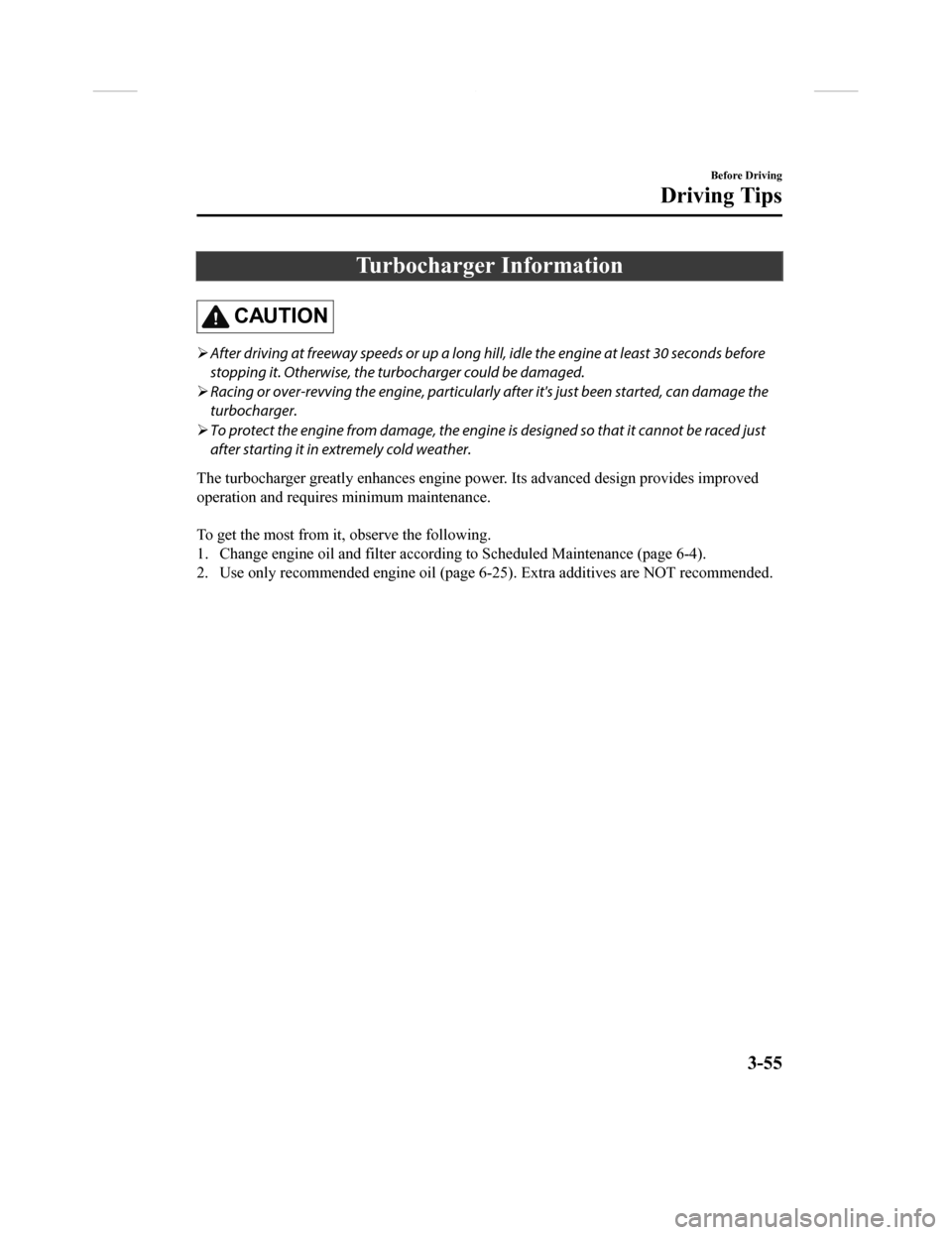
Turbocharger Information
CAUTION
After driving at freeway speeds or up a long h ill, idle the engine at least 30 seconds before
stopping it. Otherwise, the turbocharger could be damaged.
Racing or over-revving the engine, particularly after it's just been started, can damage the
turbocharger.
To protect the engine from damage, the engine is designed so that it cannot be raced just
after starting it in extremely cold weather.
The turbocharger greatly enhances engine power. Its advanced design provides improved
operation and requires minimum maintenance.
To get the most from it, observe the following.
1. Change engine oil and filter according to Scheduled Maintenan ce (page 6-4).
2. Use only recommended engine oil (page 6-25). Extra additives are NOT recommended.
Before Driving
Driving Tips
3-55
CX-9_8GC3-EA-17G_Edition1 2017-5-29 10:13:38
Page 150 of 640

▼Trailer Lights
Trailer lights must comply with
all federal, state, and local regulations. Equip your trailer as
required before towing it day or night.
CAUTION
Do not connect a trailer lighting system directl y to the lighting system of your Mazda. This
may damage your vehicle's electrical system an d lighting systems. Have a recreational vehicle
dealer or trailer rental agency connect the system, and inspect the brake lights and turn
signals yourself before each trip.
▼ Trailer Brakes
If the total trailer weight ex
ceeds 450 kg (1,000 lb), trailer brakes are required. If your trailer
has brakes, make sure they comply with all federal, state, and local regulations.
WA R N I N G
Do not connect a hydraulic trailer-brake system to your vehicle's brake system:
Connecting a hydraulic trailer-brake system directly to the vehicle brake system is dangerous
and will result in inadequate braking and possible injury.
▼ Trailer Towing Tips
•Verify that your Mazda maintains a near-normal attitude when a
loaded or unloaded trailer
is connected. Do not drive if it h as an abnormal front-up or front-down position. Inspect
for incorrect tongue load, worn suspension parts, and trailer o verloading.
•Make sure the trailer is properly loaded and the cargo is secur e to prevent it from shifting.
•Make sure the mirrors conform to all government regulations. If they do not, install
required rear view mirrors appropriate for towing purposes.
The three main causes of vehicle-trailer accidents are driver e rror, excessive speed, and
improper trailer loading.
Before driving
•Have your cooling and braking sy stem checked by an Authorized M azda Dealer.
•Before starting out, inspect the operation of all vehicle and t railer lights and all
vehicle-to-trailer connections. Stop and re-inspect all lights and connections after driving
a short distance.
Before Driving
To w i n g
3-60
CX-9_8GC3-EA-17G_Edition1 2017-5-29 10:13:38
Page 151 of 640

Driving
•Your Mazda will handle differently with a trailer in tow, so practice turning, backing, and
stopping in a traffic-free area.
•Take time to get accustomed to the extra weight and length.
•Allow more room between your vehicle and the one in front becau se braking distance
increases with a trailer. For eac h 16 km/h (10 mph) of speed, a llow at least one vehicle
and trailer length between your Mazda and the vehicle ahead.
•Avoid jerky starts or sudden acceleration.
•Avoid sudden braking. It may cau se loss of control and result in jackknifing, especially so
on wet or slippery roads.
•Shift the selector lever to the D position when towing a traile r in hilly terrain or when
heavily loaded.
The D position will allow opera ting the vehicle without frequen t shifting.
Lane changes and turning
Avoid quick lane changes, sudden turns, and tight turns. Slow d own before turning to avoid
the need of sudden braking.
A turning trailer will make a tigh ter arc than the tow vehicle. Compensate with turns that are
larger than normal.
Passing
Plan well ahead to pass other vehicles, and provide plenty of r oom before changing lanes.
Crosswinds from passing vehicles, especially larger ones, and t he effects of rough roads will
affect handling.
If swaying occurs, fir mly grip the steering wheel and reduce speed immediately, but
gradually.
Steer straight ahead. If no extreme correction of steering or b raking is made, the
combination of less speed and firm steering will result in stab ility.
Backing up
Backing a vehicle with a trailer requires practice and patience . Back slowly, and have a
helper outside at the rear of th e trailer to reduce the risk of an accident.
To turn the trailer, place your hand at the bottom of the steering wheel and turn it in the
direction you want the trailer to go. Make only slight movements to prevent sharp or
prolonged turning.
Ascending a hill
Shift into a lower gear to reduce the possibility of overloadin g or overheating the engine, or
both.
Before Driving
To w i n g
3-61
CX-9_8GC3-EA-17G_Edition1 2017-5-29 10:13:38
Page 152 of 640
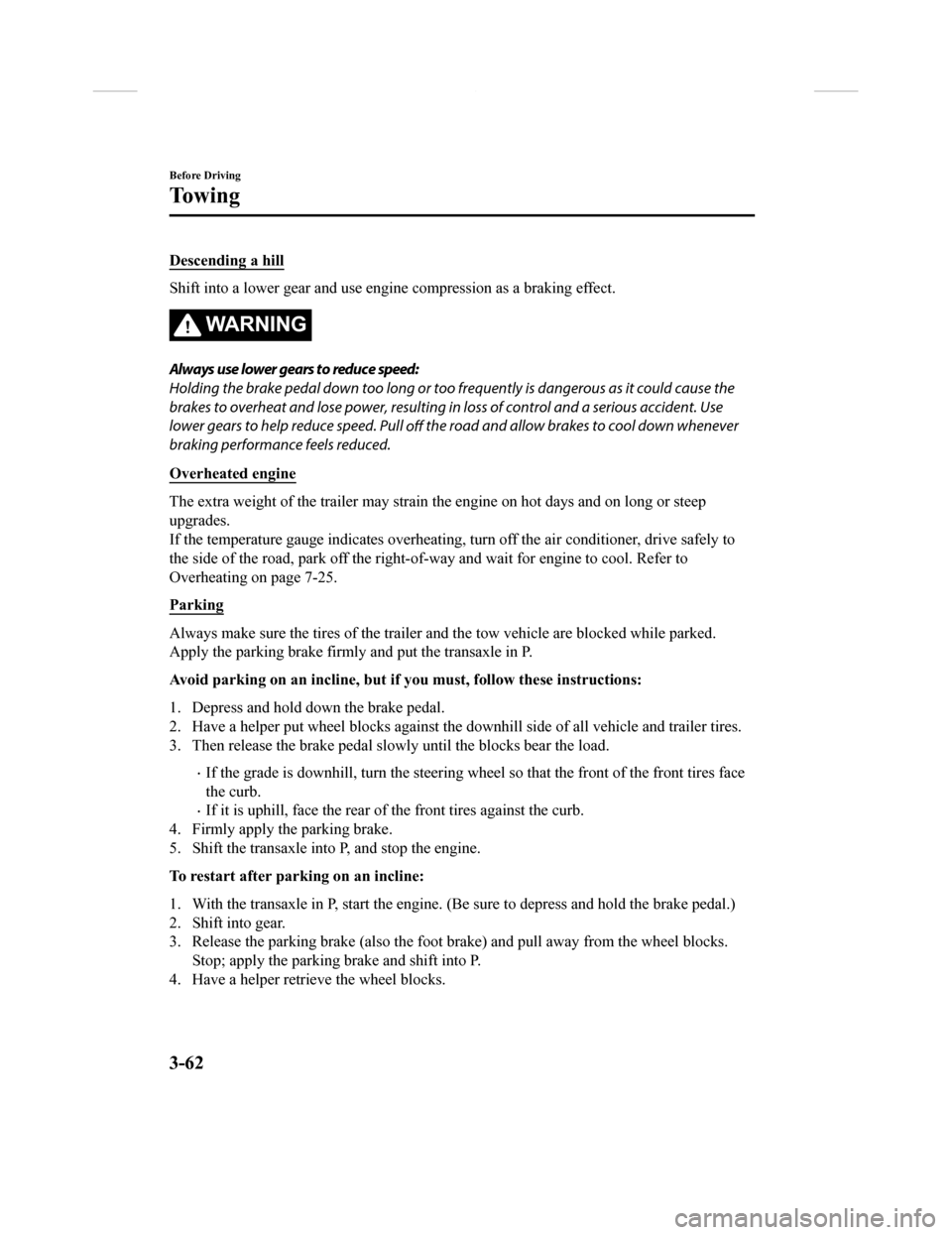
Descending a hill
Shift into a lower gear and use engine compression as a braking effect.
WA R N I N G
Always use lower gears to reduce speed:
Holding the brake pedal down too long or too frequently is dangerous as it could cause the
brakes to overheat and lose power, resulting in loss of control and a serious accident. Use
lower gears to help reduce speed. Pull off the road and allow brakes to cool down whenever
braking performance feels reduced.
Overheated engine
The extra weight of the trailer may strain the engine on hot days and on long or steep
upgrades.
If the temperature gauge indicates overheating, turn off the ai r conditioner, drive safely to
the side of the road, park off the right-of-way and wait for en gine to cool. Refer to
Overheating on page 7-25.
Parking
Always make sure the tires of the trailer and the tow vehicle a re blocked while parked.
Apply the parking brake firmly and put the transaxle in P.
Avoid parking on an incline, but if you must, follow these instructions:
1. Depress and hold down the brake pedal.
2. Have a helper put wheel blocks against the downhill side of a ll vehicle and trailer tires.
3. Then release the brake pedal slowly until the blocks bear the load.
•If the grade is downhill, turn the steering wheel so that the front of the front tires face
the curb.
•If it is uphill, face the rear of the front tires against the curb.
4. Firmly apply t he parking brake.
5. Shift the transaxle into P, and stop the engine.
To restart after parking on an incline:
1. With the transaxle in P, start the engine. (Be sure to depres s and hold the brake pedal.)
2. Shift into gear.
3. Release the parking brake (also the foot brake) and pull away from the wheel blocks.
Stop; apply the parking brake and shift into P.
4. Have a helper retrieve the wheel blocks.
Before Driving
To w i n g
3-62
CX-9_8GC3-EA-17G_Edition1 2017-5-29 10:13:38
Page 155 of 640

4When Driving
Information concerning safe driving and stopping.
Start/Stop Engine.............................. 4-4 Ignition Switch........ ..................... 4-4
Starting the Engine....................... 4-5
Turning the Engine Off...............4-10
Instrument Cluster and Display............
........................................................... 4-12 Meters and Gauges..................... 4-12
Multi-information Display and INFO
Switch
*....................................... 4-20
Active Driving Display
*............. 4-28
Warning/Indicator Lights............4-31
Automatic Transaxle....................... 4-40 Automatic Transaxle
Controls...................................... 4-40
Shift-Lock System...................... 4-41
Transaxle Ranges........................4-41
Manual Shift Mode..................... 4-43
Driving Tips................................4-48
Switches and Controls..................... 4-49
Lighting Control......................... 4-49
Fog Lights
*................................. 4-54
Turn and Lane-Change
Signals........................................ 4-54
Windshield Wipers and
Washer........................................ 4-55
Rear Window Wiper and
Washer........................................ 4-59
Rear Window Defogg er.............. 4-59
Horn............................................ 4-61
Hazard Warning Flasher............. 4-61
HomeLink Wireless Control
System
*.......................................4-62
Brake................................................ 4-66 Brake System.............................. 4-66
Hill Launch Assist (HLA).......... 4-70
ABS/TCS/DSC/Trailer Stability Assist
(TSA)................................................ 4-72 Antilock Brake System
(ABS)..........................................4-72
Traction Control System
(TCS).......................................... 4-73
Dynamic Stability Control
(DSC)..........................................4-75
Trailer Stability Assist (TSA)..... 4-76
Fuel Economy Monitor................... 4-77 Fuel Economy Monito r...............4-77
Drive Selection................................. 4-79 Drive Selection........................... 4-79
*Some models.4-1
CX-9_8GC3-EA-17G_Edition1 2017-5-29 10:13:38
Page 158 of 640
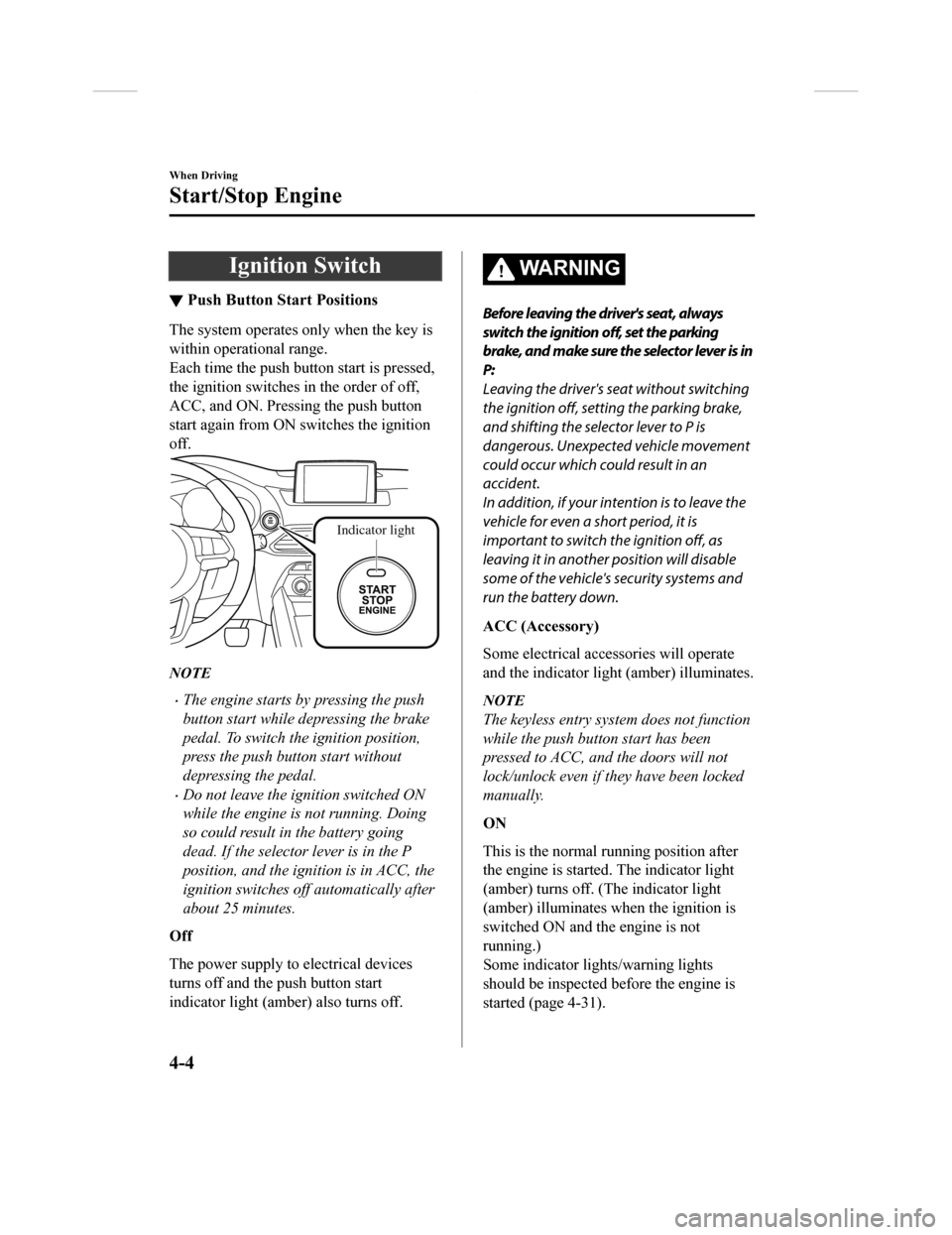
Ignition Switch
▼Push Button Start Positions
The system operates only when the key is
within operational range.
Each time the push button start is pressed,
the ignition switches
in the order of off,
ACC, and ON. Pressing the push button
start again from ON switches the ignition
off.
Indicator light
NOTE
•The engine starts by pressing the push
button start while depressing the brake
pedal. To switch the ignition position,
press the push button start without
depressing the pedal.
•Do not leave the ignition switched ON
while the engine is not running. Doing
so could result in the battery going
dead. If the selector lever is in the P
position, and the ignition is in ACC, the
ignition switches off automatically after
about 25 minutes.
Off
The power supply to electrical devices
turns off and the push button start
indicator light (amber) also turns off.
WA R N I N G
Before leaving the driver's seat, always
switch the ignition off, set the parking
brake, and make sure the selector lever is in
P:
Leaving the driver's seat without switching
the ignition off, setting the parking brake,
and shifting the selector lever to P is
dangerous. Unexpected vehicle movement
could occur which could result in an
accident.
In addition, if your intention is to leave the
vehicle for even a short period, it is
important to switch the ignition off, as
leaving it in another position will disable
some of the vehicle's security systems and
run the battery down.
ACC (Accessory)
Some electrical accessories will operate
and the indicator light (amber) illuminates.
NOTE
The keyless entry system does not function
while the push button start has been
pressed to ACC, and the doors will not
lock/unlock even if they have been locked
manually.
ON
This is the normal running position after
the engine is started. The indicator light
(amber) turns off. (The indicator light
(amber) illuminates when the ignition is
switched ON and the engine is not
running.)
Some indicator lights/warning lights
should be inspected before the engine is
started (page 4-31).
When Driving
Start/Stop Engine
4-4
CX-9_8GC3-EA-17G_Edition1 2017-5-29 10:13:38